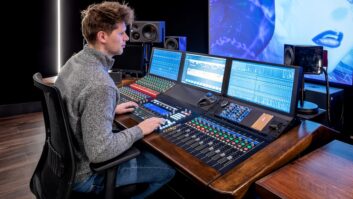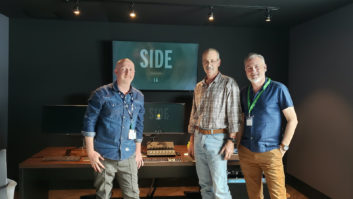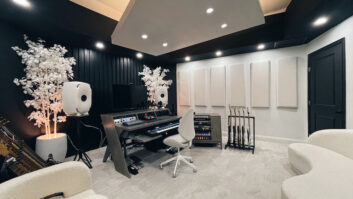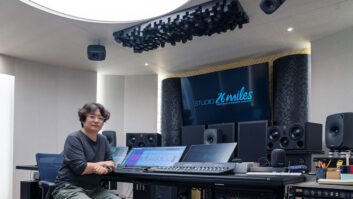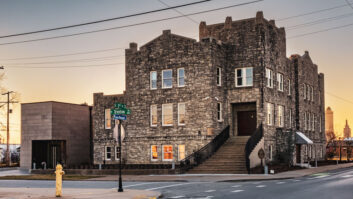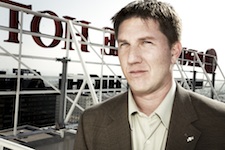
Ryan Göllner, assistant director of audio-visual services at Swank Audio Visuals
Line array systems are known for their ability to target sound more efficiently and effectively, but were you aware that they can be used to complement a production from a visual standpoint, as well? In addition to the demand for high-quality sound for events, today, clients are also requiring audio professionals to develop creative ways to incorporate audio components into stage sets. The newer micro versions of the once colossal line array systems offer a perfect option.
Thinking Visual
“When musicians get together in the studio to record, they base their decisions on what is best for the song because the song is king, but when it comes to designing audio systems for events, the room is king,” says Ryan Göllner, assistant director of audio-visual services at Swank Audio Visuals.
The 28th annual ASCAP Pop Music Awards were held at the Renaissance Hollywood Hotel and Spa in Los Angeles
At the 28th annual ASCAP Pop Music Awards, an event that was held at the Renaissance Hollywood Hotel and Spa in Los Angeles, where Göllner is part of the in-house audio team, a good part of the decision regarding the type of line array system to use was based on how it would complement the room and the stage design. “Obviously we focused on ensuring that the system was going to provide effective audio clarity, but since it was an awards show, we also centered on providing clean sight lines for the visual content that was displayed on the large screens during the course of the evening,” he explains. Ultimately, 12 JBL VerTec VT4888 midsize line array elements for the main stage audio system, with six cabinets per side, were used for the event, which brings together world-renowned musicians, songwriters, music publishers, and record labels.
In fact, “clean sight lines” is the latest buzzword in the audio world. “Even though I, personally, think speakers are beautiful since I’m an audio guy, clients simply don’t want to see them, and it’s my job to develop ways to conceal them,” says Jeremiah Leiter of Baltimore’s Maryland Sound. And that even goes for very large events. Take, for instance, Washington, D.C’.s Fourth of July Celebration on the National Mall, an event for which Maryland Sound manages the sound each year. “For the event, we use line arrays because they offer great coverage and sonic reproduction, but also because the client requested an option that would allow us to position the system in a way that was as inconspicuous as possible,” explains Leiter, who says that each year, the size of line array that is chosen is based on the projected number of people for the event.
In 2009, it was this combination of excellent sound capabilities plus visual flexibility that led Maryland Sound to choose a line array system for the Presidential Inauguration Parade. In previous inaugural parades, a 70-volt P.A. system was used along the parade route, but Leiter says the company decided in favor of the line arrays for the very first time because they knew they would not only provide impact from an audio perspective, but also be incorporated in a streamlined and visually-effective fashion.
“Clients want the system to be as sleek as possible, unobtrusive, and
impactful as far as reproduction is concerned,” says Göllner. Leiter
adds, “The good news for line arrays is that they can offer these visual
advantages, plus they offer better coverage, so that even if an
audience member is 100 feet from the stage or in the front row, he or
she can have the same audio experience.”
For the 28th annual ASCAP Pop Music Awards, Swank Audio Visuals “centered on providing clean sight lines for the visual content that was displayed on the large screens during the course of the evening,” according to Ryan Göllner.
Planning Considerations
A client’s ultimate goals for an event, in fact, often dictate the type of system chosen and how it is
worked into the visual aspects. “We have a lot of conversations on the
front end so that we can gain a solid understanding of what the client
wants to accomplish overall,” says Göllner. For a recent event held by
Volvo Powertrain that celebrated the 50th anniversary of a facility, the
company had one main goal: that the CEO actually be able to be heard by
everyone in the room.
“The HR director had told me that the audience had never been able to
hear the CEO clearly in the room at any event held previously, so we put
this goal on the top of our list when choosing a line array system,”
explains Leiter. In order to do that adequately, the company had to
consider the challenges that they had to compensate for, including the
concrete floor; block walls; the dimensions of the room, which happened
to be very wide but not deep; how the sound would reflect off the walls;
and all of the significant ambient noise within the working factory,
itself. On top of that, of course, Leiter and his team had to ensure
that the system chosen would not draw attention to itself, but rather,
would blend into the stage design. “Ultimately, we had four different
models of JBL line arrays to choose from, and we selected the one that
provided the clarity that the client demanded, while not overpowering
the space that we had to work with,” says Leiter.
Maryland Sound managed sound for the 2009 All Points West Music & Arts Festival in Liberty State Park in Jersey City, N.J.
Photo: Ed Friedlander
There are, in fact, a number of additional factors in choosing an
appropriate system that most likely would never appear on the client’s
radar. These involve balancing the various aspects of a production,
including the lighting, the video, and the audio. Göllner says the
proper balance will ensure that the focus of the event is highlighted
appropriately. “If we’re talking about a company meeting that will focus
on motivating attendees and communicating key goals, I’m going to
approach it much differently from a philosophical standpoint than I
would if it were a music event featuring live performers, like the ASCAP
Awards show,” he says.
Other important considerations include the following:
• whether the event is indoors or outdoors
• the size and shape of the coverage area
• how far the sound needs to project to reach the last guest
• how reverberant the room is; and
• if there are obstacles that will impede the placement of the line arrays.
“No matter whether it’s a performance or a meeting, I always weigh each
of the respective aspects of an event, put together a package that is
going to address each of the issues adequately, and consider what the
average attendee coming into the room will see,” says Göllner.
A Shrinking Trend
What attendees are used to seeing—in their everyday lives—is technology that
gets smaller and smaller. Line array systems are no exception to the
trend. It certainly wasn’t always that way, however. “Back in the day,
audio would get ‘wall of sound’ setups that would not only slam the
audience with as much sound as they could handle, but would also
dominate stage designs,” says Göllner.
Jeremiah Leiter of Maryland Sound at the All Points West Music & Arts Festival
Photo: Ed Friedlander
“One of the great things about midsize line array systems is that they
not only offer us great coverage over long distances, but they can be
set up in a manner that doesn’t call for big, all-consuming scaffolding,
as once was the case,” adds Leiter.
Just how compact one goes, of course, depends largely on the source that needs to be amplified. For the galas and balls that Maryland Sound
often does, for instance, vocal reinforcement—as opposed to music
reinforcement—is the focus, so the company can use very small line
arrays that can blend in with the natural architectural design of a
building and offer adequate coverage where needed. “We often use digital
steerable line arrays at these types of events because we can use phase
and steer the speakers to the left or right as necessary to keep sound
off walls, reduce feedback, and create better vocal clarity,” explains
Leiter.
The ASCAP Awards Show was a slightly different animal, as it was essentially a cross between a concert that you’d see at a festival and a
gala dinner that featured speakers, so there were several factors that
had to be weighed. “When making our decision, we wanted to ensure that
we got the power we’d need for the music portion plus the clarity we’d
need for a talking head event,” says Göllner. Of course, considering
that the event was attended by some of the biggest songwriters and music
professionals in the business—who were both performing and
speaking—making the right choice was extra critical.
PopMark Media
is a creative partnership developed to help music industry
professionals, filmmakers, advertising agencies and business
professionals make sense of the changing requirements, develop effective
strategies and stand out in a sea of competitors. The company offers
innovative and personalized services that include a full range of
promotional, social media and strategy consulting; original music
composition, jingle production and music supervision; and sound
polishing services for various projects.
